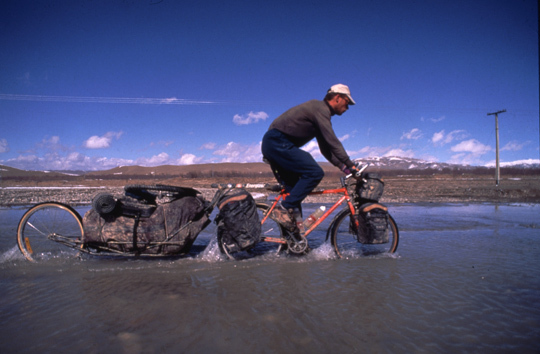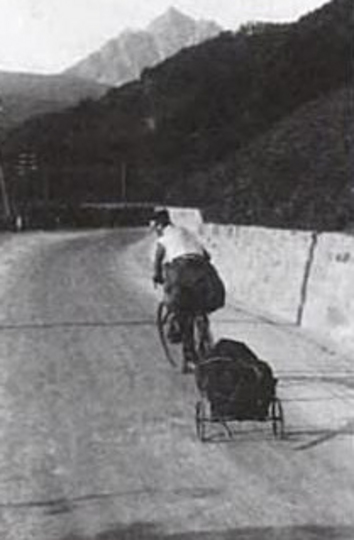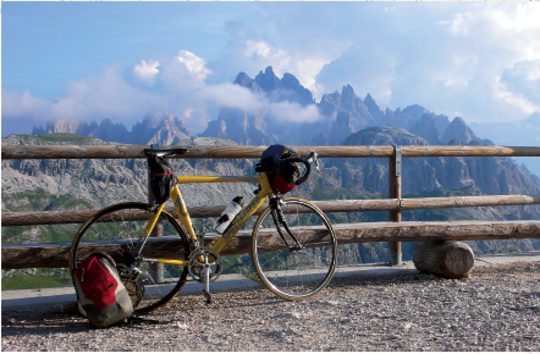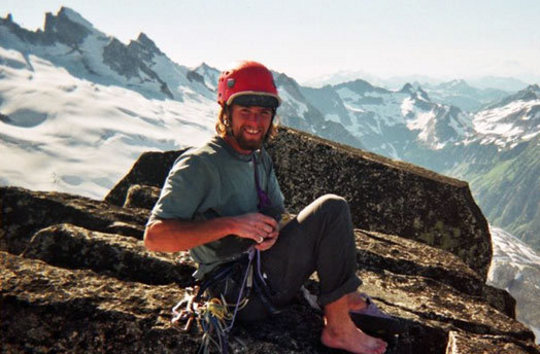
Goran Kropp rides through Pakistan on his way to Mt. Everest. In 1996 Kropp rode from his home in Sweden to the mountain and back while carrying his climbing gear. On his first attempt on the mountain he broke trail through the Icefall so he would have the option of using pre-placed ladders or fixed ropes. Kropp died in a rock climbing fall in 2002. [Photo] Fredrik Blomqvist / Blomqvist Produktion Sweden
After several hours, the small of their backs ached. Their fingers became accustomed to the grip of the handlebars and peeling them off was like oiling old machinery. The bikes, heavy enough on their own, were laden down with the weight of climbing equipment. But, slowly their legs grew stronger from the effort, and the 300km of riding were well worth the secret they held close to their heaving chests.
It was August of 1931 when the brothers Franz and Toni Schmid put aside their bikes at the base of their dream: the north face of the Matterhorn. At the time, it was one of the most significant unsolved problems of the Alps. Teams of eager climbers traveled to the region, hoping to claim the first ascent of the north face of the Matterhorn, the Eiger or Grandes Jorasses. They pooled their resources and used whatever means necessary to reach the mountains. By the time the climb began, the manner in which they reached mountain’s base was more or less trivial. The achievement was the summit. And yet, imagining this historical moment as just the time spent on the face diminishes the accomplishment. The adventure didn’t begin when these spirited climbers roped up. It began as they crafted protection at home, as they packed their hemp ropes onto their heavy bicycles, and as they began peddling. For the Schmid brothers, it began in Munich. These men demanded everything from their bodies, and their spirits, long before the Matterhorn was in eyesight.
The brothers climbed the face. At 4478 meters they stood, triumphant and utterly spent. And yet, there was probably some quiet, persistent voice whispering an unpleasant reminder in the back of their minds: Nice job. Now get down there and ride back home.

Heckmair midway through a long approach [Photo] Anderl Heckmair
When men were racing each other to every unclimbed face, bicycling was not the ideal form of travel. Aside from being time consuming, there were risks: a sliced tire, fractured spokes, a sudden crash and the swift snap of a collar bone. But this was a choice often driven by necessity. Although glory and publicity came with solving the last great problems of the Alps, the talented men tackling these problems were by no means wealthy. Anderl Heckmair, for example, was employed by the city gardens Munich. But Heckmair’s hobby of taking time off to romp in the mountains made him a less-than-ideal employee. The gardens “regarded [his] mountaineering ambitions without enthusiasm.” In 1929, that risk became reality. A day of aggressive skiing landed Heckmair in the hospital with bruises and a broken tailbone. While still in the hospital, the city gardens informed him he was being let go. But Heckmair didn’t lose any of his ambition, and even gained some funds. Until he was released from the hospital, the city could not lawfully dismiss Heckmair from his job. He continued to receive his wages, sickness benefits and money from his insurance policy. After healing, he crafted a trailer for his bicycle. With the 1000 marks of hospital savings, he and his friend Hans Brehm cycled to the Dolomites. Later, in 1931, he would ride his bicycle 400km with Gustl Kroner to Chamonix to make an attempt on the Grand Jorasses. This time, he had his equipment shipped ahead. While the decision made the burden lighter, it also meant an exercise in patience. The pair sat and waited in Grand Blanc for two weeks before their gear finally reached them.
Arguably one the greatest climbers of his time, Riccardo Cassin also bicycled his way to the base of many climbs. He worked five days a week at a steel mill, with mountains in view of his daily commute. The weekends were priceless. With the little time he had available to him he climbed. Of course, when he set his sights on something farther away, it took quite a bit more to get there. Cassin once described his journey to the Grandes Jorasses, where he made the first ascent of the Walker Spur: “I had to take the train to Pre-Saint-Didier, bike until Courmayeur and then walk to the Col du Geant, do half of the Mere de Glace as far as the Refugio Leshaux, and then get to the Grandes Jorasses plateau and start the climb. So I was already warmed up by the time I got to the base of the wall!”
In the past 80 years, the character of mountaineering has changed significantly. There have been fewer and fewer peaks that have not been summited. By the 1960s, even the 8000-meter giants had been overcome. Mountaineers need new goals: climbing established routes faster, more efficiently, testing modern training methods on harder lines. And while alpinism remains a challenging and awe-inspiring enterprise, it lost some of its enchantment. Colorful pieces of gear are available at the local shop or the Internet. And the climbs are at most a few days drive away. Airplanes and helicopters allow climbers to access remote peaks without a multi-month long approach. Still, there are some mountaineers who are dissatisfied with oversimplification.
The Full Experience
The desolation of the Pakistani desert was almost welcome. After days of violent threats upon his life, endless questions from curious onlookers, broken spokes and illness, Goran Kropp was finally alone. The weight of the trailer in tow seemed lighter. He kept an eye on the bicycle’s odometer: 4,489 miles…4,490…4,491… In the stillness, he allowed his thoughts to wander back to Sweden. Back to those who doubted his strength and integrity. Kropp recalled a certain tabloid writer dismissing his cycling as “pointless” should he use the routes and ladders already established in the Khumbu Icefall, a dangerous segment of the South Col route to Everest’s summit. For a moment, he peddled harder. Those people–his doubters–didn’t know what he was capable of. 4,493…4,494… If he could navigate this distance on bicycle, then he could make his own way through the Icefall as well. Perhaps I should give her something to think about. Nothing is impossible. (quoted p. 63 ultimate high)
At the end of this ride, still several thousand miles away, Kropp’s goal was to scale Everest without oxygen. Throughout the 1990s, he had started to view the tourism of Everest as a canker on the mountainside. “If the goal of mountaineering was just to save time and effort, then I would have been satisfied scaling Everest with the Saab aircraft,” he says in his book, Ultimate High. Instead, he packed all of his gear and rode from his home in Sweden 7,000 miles to Kathmandu. Kropp’s self-imposed challenge did not end there. He scoffed at the idea of having others haul his gear to base camp.
With that, the second challenge began. Cramming all of his food and equipment into a pack, he set off with this 143-pound load. His girlfriend, Renata Chlumska, paced back and forth along the road as he walked with inhuman slowness. His goal wasn’t base camp; It was the next bench, the next crest, the next turn. After a few weeks, when he finally established himself in camp, the other expeditions had long been set-up.
Kropp’s first bid for the summit would fail. His fitness abandoned him, and time seemed to move swiftly when he could not. Knowing fully well the dangers of reaching the summit too late in the day, Kropp turned back. Before he could try again, he would watch the 1996 tragedy unfold. After the storm broke, Kropp tried again and met success. After his descent, he bolstered his health for a month and took off for Sweden, once more on his bicycle. “We are all different,” wrote Kropp. “Some of us have wilder dreams than others.”

Maxime Turgeon’s gear for his 18 day, 1236km alpine tour. [Photo] Maxime Turgeon
In 2009, another dreamer began his odyssey. Maxime Turgeon had ambitions fueled by figures of mountaineering history. “I daydreamed about the story of Hermann Buhl biking through the night from Austria to Italy in 1952. By afternoon, he’d made the first solo ascent of the northeast face of the Piz Badile, with only a thin rope, a few pitons, some slings and carabiners… Almost sixty years later, I felt that same need to get back to the simplest form possible.” Turgeon took to his bicycle for a climbing tour of the Alps, covering a distance of 1,236 kilometers and climbing seven classic 500m to 1000m routes solo. Every moment of his quest–not just the climb–was significant. In his essay “A Simple Line” in Alpinist 30, he asks “How could you truly understand a chain of mountains without linking each kilometer to each?” As he covered those kilometers, he reflected on a past that had guided his future, and rediscovered a landscape he thought he’d known well.
With spiritual journeys like these capturing our attention and imaginations, it’s almost easy to forget another group of climbers. Like Cassin, there are still the young and determined scraping together a meager living within sight of the mountains, doing whatever it takes to climb them.
For Jens Holsten growing up in Northwest Washington, bicycling to climbs was the norm from the beginning. Climbing became a part of life before a driver’s license did, so Holsten’s bicycle was the logical vehicle. When he moved to Central Washington, this didn’t change. In fact, it was almost easy. “From where I live right now, it’s maybe like 15 miles from my front door to where I get off the bike and start hiking. Maybe gaining a little elevation depending on where you’re going. Where I live is really conducive to biking to climbs. It would be harder other places for sure.” That being said, no one was typically eager to join Holsten for the cycling portions, and if he could find a ride he wasn’t shy about taking it.

Holsten enjoying success atop the remote, but increasingly popular, North Gunsight after the first free ascent. It took him and Hasson two days to approach the climb, and two days to descend back to their vehicle. [Photo] Max Hasson
In 80 years, climbers haven’t lost their knack for pinching pennies. As gas prices go up, the sport becomes more demanding than it already is. When Holsten’s ambitions grew, he wondered what it would take to accomplish them. “I was really excited to do some bigger climbs in places different from my home, and I thought this required me to make a lot of sacrifices. I didn’t have a rig, but it worked for me because I was really motivated and I looked at it as training to be biking around and going climbing.” And training it is, both mentally and physically. “It’s about extending my body for really long periods of time. You usually drive your car up to the trail head, go climbing and come back hours and hours later to collapse in your car. But having to ride your bike before and coming down and having to ride a significant ways home not only increases your physical fitness, but also your mental toughness.”
Still, Holsten found the choice of peddling to the mountains more than just necessity. Although the ride was always motivated and dominated by thoughts of the climb, it was still part of the experience. These were human-powered adventures, from start to finish. “Sometimes I would run instead of bike,” said Holsten. “You know, anything that’s sort of having that experience one-hundred percent fueled by me and my body.” And even at the moment on the summit, when there would lurk that sinking feeling to remind Holsten of the ride home, there would also be satisfaction. When you can no longer go up, you can still look out at where you came from.
Ultimately, the distance covered makes little difference, whether it was ten miles or several hundred. Nor does it matter if the mountain or route chosen was tread countless times before. For those that take this extra challenge, regardless if it’s to save pennies or find something greater, it is a chance to reconnect with history, as well as test the limits of one’s own endurance and will.

Goran Kropp in Turkey on his way to Everest. Kropp’s style has not taken hold within the climbing community. Few people today climb 8000m peaks without bottled oxygen, let alone without air transport, camp support, or motorized approaches. [Photo] Fredrik Blomqvist / Blomqvist Produktion Sweden